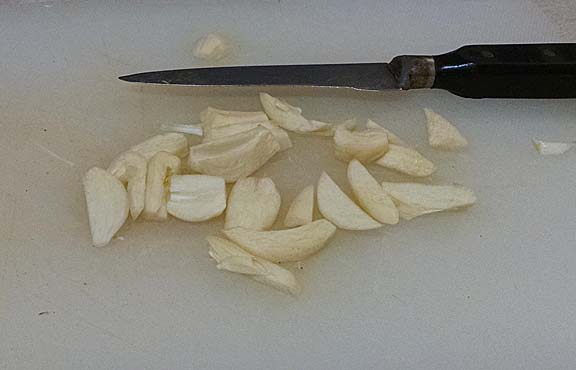Chicken thighs, mushrooms and garlic in a creamy sauce! This is sure to impress!
Ingredients:
3 boneless/ skinless chicken thighs:
For
Mushroom Sauce:
- 2 cloves garlic crushed
- 2 teaspoons balsamic vinegar
- 1 cup sliced brown mushrooms
- ½ cup light cream or reduced fat cream
½
cup dried cranberries
Directions:
Before
cooking, salt and pepper the chicken and allow to stand 30 minutes
at room temperature.
Cut
up the garlic. Be sure to pry out any green parts, they are very
bitter. Also rinse and drain the mushrooms.
Heat
a large skillet over medium-high heat. Add 1 tablespoon of oil in and
swirl to coat. Lay the chicken into the pan away from you, cook 5
minutes on each side or until browned.
Remove
the chicken and tent with foil to keep warm.
Reduce
heat to medium-low; add 2 tablespoons of butter, and the mix of
mushrooms and garlic. Stir this well. Add the balsamic vinegar and
scrape up any brown parts left in bottom of pan. You will want this
to flavor your sauce. Cooking for a further 1-2 minutes, or
until the you start smelling the garlic.
Stir
in the cream until well mixed. Place the chicken back in the pan and
cover. Reduce heat and let simmer for 5 minutes.
Stir
in the cranberries just before pulling the chicken out to the
platter. Spoon the sauce over the chicken.
Serve
chicken with the mushrooms sauce and a side of green vegetables.
What
a meal to serve my Master!
For
our music: https://www.youtube.com/watch?v=GfZPtkqXQIA
socialslave
To
satisfy and restore.
To
nourish, support and maintain.
To
gratify, spoil, comfort and please,
to
nurture, assist, and sustain
…..I
cook!
Please
buy slave's cookbook:
The
Little Black Book of Indiscreet Recipes
by
Dan White
http://www.amazon.com
=====================================
==========================
It
was a time that politics and religion were one and the same. The
Pilgrims left England in 1622
to escape that mix.
In
1636
John
Atherton was appointed a bishop
of the Church
of Ireland.
He was not welcomed by the Roman
Catholic majority
in his see. For nearly five years, Bishop
Atherton was
one of the loudest
and
most anti-gay
proponents for a new
law
making homosexuality a capital
crime.
Then in 1640 Atherton was accused of buggery with a man, John Childe, his steward and tithe proctor. They were tried under that law that Atherton himself had helped to institute. They both faced the death sentence.
The
Bishop's fellow clerics did what they could to defend him, to avoid
disgrace to the reformed religion of
Ireland. Throughout the case he pleaded his innocence in the face of
flimsy evidence. His sole accuser was a man lacking integrity and
credibility. It was his word against John’s. The accuser won the
day and the outcome was inevitable.
Years
later, the man on whose sole evidence John was condemned, was himself
brought to justice and hanged. At the gallows, he confessed his sins
and in that confession declared that the accusation against John
Atherton had been completely false.
It
is said that during the trial, Atherton burned a bundle of papers,
which he had written out of law books, for his own defense.
Reports
said that Atherton's attitude during the trial was 'by all
condemned;' but when the fatal issue became manifest his manner
changed. Three times daily Dr.
Nicholas Bernard visited
the prisoner, who became penitent,
and faced the penalty with equanimity.
'The
magnanimity of the man,' says Bernard, 'I did much admire.' When news
of a possible reprieve came, 'it moved him not, as rather choosing a
present deserved
death
than the prolonging of an ignominious life; whereby the scandal would
but increase'.
He
always denied the specific
charge of sodomy,
and did so once again from the gallows before he was hung on December
5th.
His
lover John
Childe
was hanged shortly afterwards at Bandon Bridge.
This
was the second pair of men executed for sodomy in the history of the
United Kingdom.
(the
first men executed for sodomy were Lord
Audley,
Earl of Castlehaven and his two menservants, in 1631.)
A
contemporary pamphlet, The Life and Death of John Atherton (1641),
remains.
However the trial records, were
destroyed
in the Jacobite
rebellion that
broke out almost
immediately after
Atherton's execution.
Fifty
years later Atherton
was
defended as a
victim of a conspiracy,
on evidence gathered from “people recently living”.
They
said the main reason for the Bishop's disgrace was his political
efforts in opposing the
Articles of Irish Convocation
in 1634,
and the personal hatred of the Earl
of Cork,
whom he had successfully sued in a dispute over land rights.
Atherton's patron, the Earl
of Strafford,
also an enemy of the Earl of Cork, was executed
for treason in
May 1641.
Others
said Atherton's demeanor was clearly incompatible with the idea he
was the innocent victim of a vile conspiracy. It is to be noted that
none of his accusers were Roman Catholics.
The
Bishop's body, by his own desire, was buried in the obscurest part of
St. John's churchyard, Dublin.
From
our vantage point nearly 400 years latter we can see that both sides
were using the Bishop's memory for their own political gains.
But
what about the man behind the title? Was he gay? There is no true way
of telling. Yet just this week we hear the news of another anti-gay,
homophobic person of power being caught having homosexual relations.
Did he protest too much?









No comments:
Post a Comment